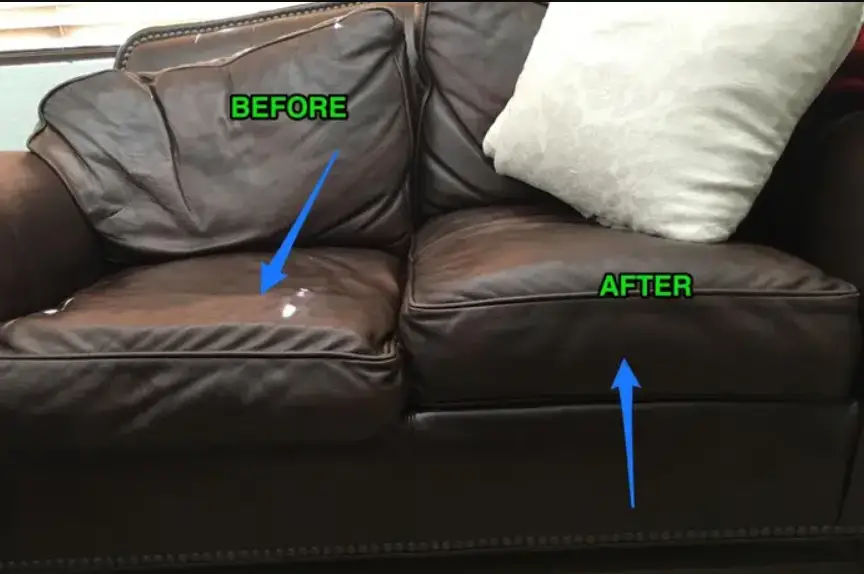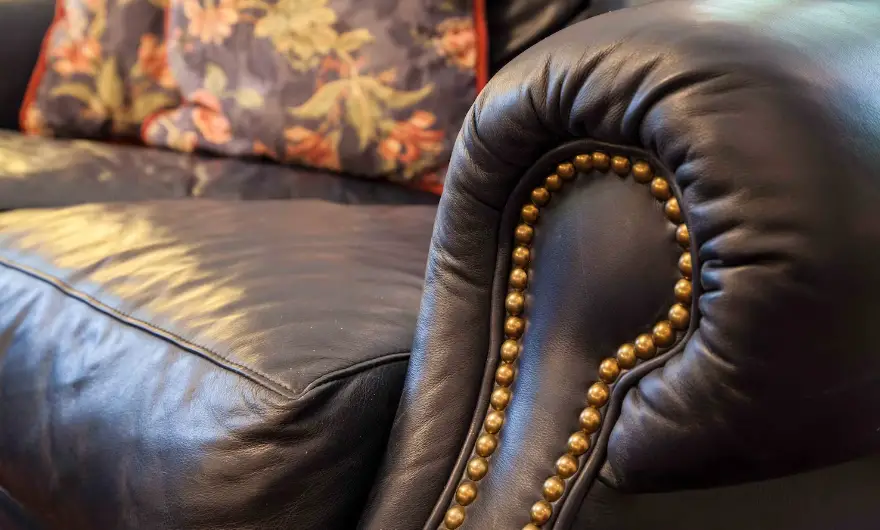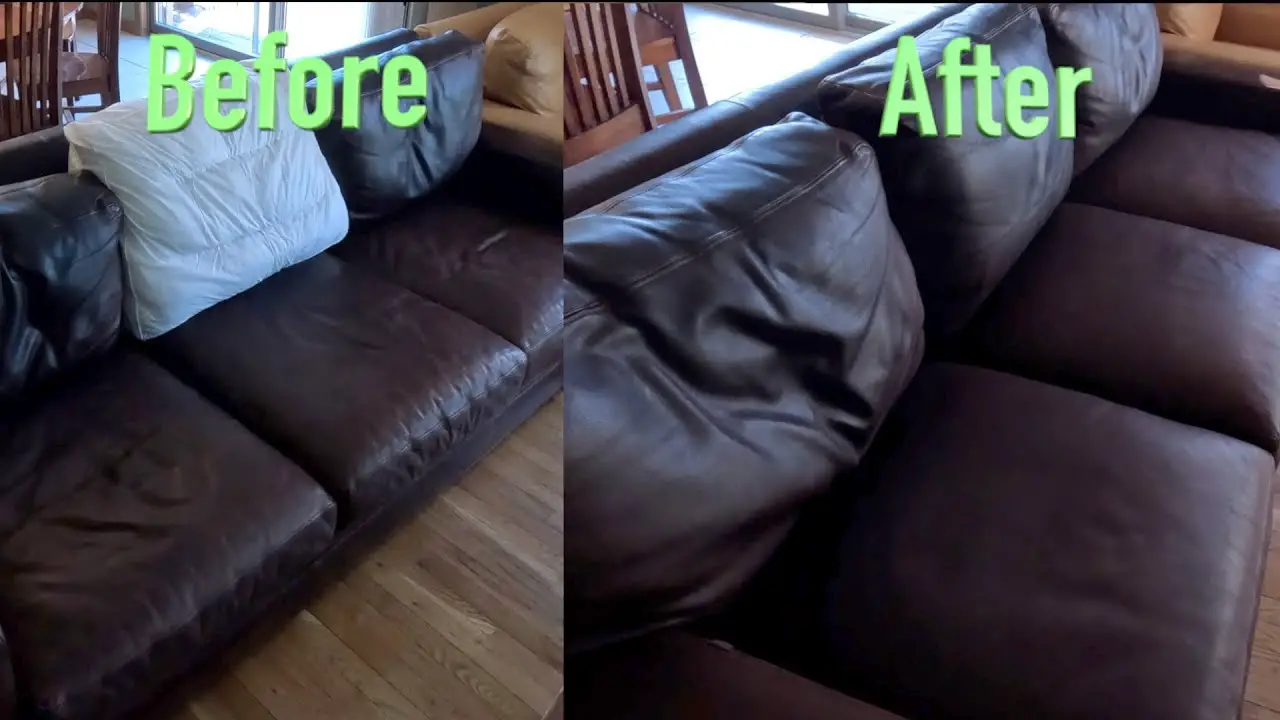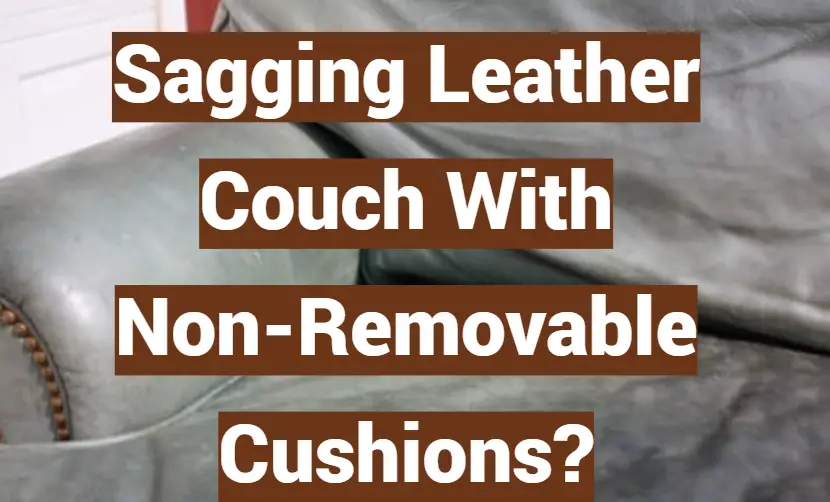Having a sagging leather couch can be really uncomfortable and unpleasant to sit in. But, if your couch has non-removable cushions, it may seem impossible to repair the sagging. Don’t worry! You can still fix the problem without having to buy a new couch. In this article, we will cover some tips on how to repair a sagging leather couch with non-removable cushions.
What causes leather sofa sagging?

Weak sofa frame
The first and most common cause of sagging is a weak frame. If the frame of your leather couch is made from low-quality materials or has been damaged, it may not be able to support the weight of you and other people sitting on it. This will result in the cushions sinking down and creating a sagging appearance.[2]
Worn-down or weak sofa springs
Another common cause of a sagging leather couch is worn-down or weak sofa springs. Sofa springs are used to support the cushions and can become weakened over time due to regular use or simply age. If your couch has been in use for many years, the springs may have worn down and need to be replaced in order to keep the cushion from sagging.[2]
Poor quality cushions
If the cushions on your leather couch are made from poor quality materials, they may start to sag over time. Lower-grade foam and other fillings can break down quicker than higher-quality ones, leading to the cushions sagging.[2]
Normal wear and tear
Finally, normal wear and tear over time can also cause the cushions on your leather couch to sag. As you and family members sit down and get up from the couch, the cushions will eventually start to sag due to the constant use. This is especially true if there’s a lot of activity on the couch or it’s used by many people.[2]
Establishing the problem

Sagging leather couches with non-removable cushions can be a real headache. It’s not only unsightly, but it can also have an impact on your posture if you spend too much time sitting on it. Fortunately, there are some simple solutions to this problem that you can do yourself at home.[3]
Frame repairs
When dealing with a sagging leather couch with non-removable cushions, the most common solution is to repair the frame. If your frame has become weak or damaged over time, this could be causing the sagging. To repair it, you will need to replace either part of it (such as one section) or all of it. It’s best to replace all of it if possible, so that the couch is more structurally sound.
The most important thing when replacing your frame is to make sure you get one that fits properly and is made of a strong material like hardwood or metal, not a flimsy plastic or particle board. It should also be properly fastened together with screws, bolts.[3]
Webbing repairs
If the webbing on your sagging leather couch with non-removable cushions has become worn or stretched out, you might need to replace it. This repair should only be done if the frame of your couch is still in good condition and all other repairs have been tried first. Replacing the webbing involves removing all of the old webbing from the frame and replacing it with a new webbing.
To get started, you’ll need to obtain replacement webbing for your couch. You can purchase webbing from furniture stores that specialize in upholstery supplies or you may be able to find it online. Once you’ve obtained the right size and type of webbing, you’ll need to remove all of the old webbing from the frame. You can do this by cutting it out using a pair of scissors or a utility knife.
Once the old webbing has been removed, you can begin installing the new webbing. Start at one end of the couch and work your way down to the other end.[3]
Spring repairs
One of the easiest and least expensive ways to repair a sagging leather couch with non-removable cushions is to add or replace worn springs. If your existing springs are intact but just need to be tightened, you can use pliers or a spring puller to do so. Be sure not to over-tighten the springs as this could cause further damage.
If your existing springs are completely worn out, you will need to purchase replacement springs and appropriate tools such as a spring hook or pliers for installation. Measure the size of the existing springs before purchasing replacements, as sizes can vary considerably from model to model.[3]
How to stop leather sofa sagging

Flip and fluff the cushions regularly
Flipping and fluffing the cushions of your leather couch regularly is one of the best ways to stop it from sagging. This simple task helps distribute the cushion’s fill evenly, preventing them from settling in one spot and becoming lumpy or saggy over time. To do this, simply remove the cushions from the sofa and turn them inside out. Then, give them a good shake and fluff to help redistribute the fill. For best results, do this every few weeks or so.[1]
Use sofa cushion supports
If your leather couch has non-removable cushions, then you’ll want to invest in some sofa cushion supports. These supports are designed to fit underneath the cushion and help provide extra support and comfort while preventing sagging. To use them, simply place one under each of your couch’s cushions and adjust it as needed for optimal support.[1]
Fix the sagging sofa with plywood
If your leather couch is already sagging, you can try to fix it by adding a layer of plywood underneath the cushion. This will help provide extra support and reduce any sagging that may have occurred over time. To do this, measure the size of your cushions and cut a piece of plywood slightly smaller than them. Then, place the piece of plywood underneath the cushion and secure it with screws or nails.[1]
Replace the springs
If the sagging on your leather couch is caused by broken or worn out springs, then you’ll want to replace them. To do this, you’ll need to remove the cushion from the sofa and inspect the springs for signs of wear and tear. If necessary, unscrew them and replace them with new ones. This will help support your cushions better and reduce any sagging.[1]
Change or refill the cushions
Last but not least, if your leather couch cushions are sagging because of old or worn-out fill, then you may need to change or refill them. To do this, you’ll need to remove the cushions from the sofa and inspect them for any signs of wear and tear. If necessary, replace the fill with new material or add more filling as needed. This will help provide extra support and comfort while reducing any sagging.
With a bit of effort and the right tools, you can easily repair your leather couch’s sagging cushions and keep it looking like new for years to come.[2]
Anti Slip Your Cushions
To keep your cushions from slipping, you can use an anti-slip pad under each cushion. This will help keep them in place, as well as providing additional support and comfort. To do this, simply measure the size of your cushions and cut a piece of non-slip material slightly smaller than them. Then, place the material underneath the cushion and secure it with screws or nails.[2]
Add Cushion
Cushion covers can also help reduce any sagging that may have occurred over time. To do this, simply measure the size of your cushions and choose a suitable cover for each one. Then, slip the covers onto the cushions and secure them with zippers or buttons as needed. This will help keep your cushions looking new for longer while providing additional comfort and support.[2]
Repair a sagging leather couch with non-removable cushions
If your leather couch is beginning to sag and look worn, you don’t have to replace it just yet. You can repair a sagging leather couch with non-removable cushions with a few simple steps.

First of all, you need to make sure that the frame isn’t damaged or broken in any way. If it is, you will need to get it fixed before doing the repair. If the frame is still in good condition, you can proceed with the repair process.
Now that you have confirmed that the frame is not damaged or broken, the next step is to assess the cushions of your leather couch. Look at each cushion individually and check for any signs of damage such as cracks, rips, or tears.
If there are any visible signs of damage, you will need to repair each cushion before attempting to fix the sagging.[2]
FAQ
How do you Refluff non removable couch cushions?
Refluffing non-removable couch cushions is not as difficult a task as it may seem. The key to success is to be gentle with the cushion’s fabric, and use your hands or a spoon to break up the cushion’s lumps and even out its surface. First, you will need to remove any excess stuffing on the cushion.
Then, gently use your hands or a spoon to break up the stuffing and remove any lumps from the center of the cushion. Next, add small amounts of stuffing back into the cushion until it is full but not overstuffed.
Finally, use your hands to even out the surface and give it a good fluffing.
How do you fix a sagging couch with fixed cushions?
Your first step in fixing a sagging couch with fixed cushions is to determine the cause of the problem. If the cause is simply wear and tear, try refluffing or adding more stuffing to the cushion. If it’s a structural issue, such as a broken frame or damaged springs, you may need to replace those parts.
How do you tighten a loose leather couch?
If your leather couch is starting to feel a bit loose, the first step to tightening it is to identify any loose screws or bolts. If you find any, simply tighten them up with a screwdriver or socket wrench. You may also need to replace broken springs, padding, and other components. Finally, consider adding additional support such as straps or blocks under the sofa.
Can you tighten loose leather?
Yes, you can tighten loose leather. The most common method is to use a leather conditioner with an applicator sponge or cloth to rub it onto the leather surface. This will help add moisture and make the leather less brittle, and therefore less likely to stretch out over time.
Can a sagging couch be fixed?
Yes, a sagging couch can be fixed! Depending on the cause of the sagging, you may need to simply refluff the cushions and add more stuffing, replace broken components such as springs or padding, or use straps and blocks to provide extra support. With some patience and attention to detail, you should be able to repair your sagging couch in no time.
What is the solution for sinking the couch?
The solution for sinking the couch depends on the cause of the sagging. If it is due to worn out stuffing or padding, you may need to replace these components and/or add more stuffing to refluff the cushion. If it’s a structural issue such as broken springs, you may need to replace those parts as well. Finally, consider adding additional support such as straps or blocks under the sofa.
Good luck with your repair project and happy fluffing! With a little patience and effort, you should be able to get your sagging couch looking like new again in no time.
How can I make my couch firm again?
Making your couch firm again can be done in a few ways. First, check for any loose screws or bolts that need to be tightened up. If the sagging is due to worn out stuffing or padding, you may need to replace these components and/or add more stuffing to refluff the cushion. If it’s a structural issue such as broken springs, you may need to replace those parts as well. You can also add additional support such as straps or blocks under the sofa for extra support. Finally, if your couch still isn’t firm enough, consider switching out the cushions for more supportive ones.
Why is my couch sinking in the middle?
Your couch may be sinking in the middle for a few reasons. First, check to see if there are any loose screws or bolts that need to be tightened up. If the sagging is due to worn out stuffing or padding, you may need to replace these components and/or add more stuffing to refluff the cushion.
Useful Video: How To Fix a Leather Sagging Sofa | Super Simple
Conclusion
Leather couches with non-removable cushions can be repaired to look like new. It’s a great way to save money and prolong the life of your furniture. To properly repair a sagging leather couch, you will need foam padding, Dacron fiberfill batting, and heavy-duty staples. Start by taking off the old cushion material. Then, measure the new foam padding and cut it to fit the cushion shape. Place it inside the cushion cover and add a layer of Dacron batting on top. Finally, staple the material in place, trim any excess length, and replace your leather couch cushions. With just a few simple steps you can repair a sagging leather couch with non-removable cushions and enjoy its new look for years to come.
If you have any further questions or need additional tips, feel free to contact a professional furniture repair specialist. Good luck with your project!
References
- https://www.ehow.co.uk/way_5399045_rebuild-mgb-cars.html
- https://leatherinsights.com/leather-sofa-from-sagging/
- https://suggesthow.com/how-to-fix-a-sagging-couch-with-attached-cushions/







Leave a Reply